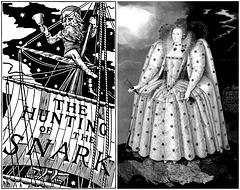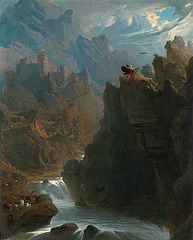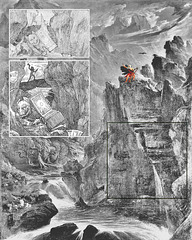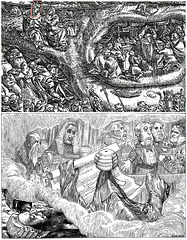![«L.C. forgot that "the Snark" is a tragedy and [should] on no account be made jovial.» «L.C. forgot that "the Snark" is a tragedy and [should] on no account be made jovial.»](https://cdn.ipernity.com/200/59/72/42015972.828ca640.75x.jpg?r2)
Snark Gallery
Folder: The Hunting of the Snark
My favorites from www.ipernity.com/doc/goetzkluge/album/321355
Henry Holiday's Snark illustrations: www.ipernity.com/doc/goetzkluge/album/781570
"Snark" Portal:
www.snrk.de
«L.C. forgot that "the Snark" is a tragedy and [sh…
| |
|
Letter by C.L. Dodgson (aka Lewis Carroll) to Henry Holiday. The two lines at the bottom are by Henry Holiday.
Source: www.pbagalleries.com/images/lot/1859/185970_0.jpg in www.pbagalleries.com/view-auctions/catalog/id/384/lot/119222/Original-drawing-by-Lewis-Carroll-in-illustration-of-The-Hunting-of-the-Snark-and-an-autograph-letter-from-him-to-the-book-s-illustrator-critiquing-his-designs-bound-into-a-copy-of-the-book
"... The letter, dated Jan. 4, 1876, highlights Carroll’s and Holiday’s different artistic vision for the book, and critiques Holiday’s illustrations for the work both generally and in particular ..."
Snapshot 2016-05-26
Processed (GIMP): high pass filtering and contrast enhancement
The note is:
«L.C. forgot that "the Snark" is a tragedy and [should]
on no account be made jovial. h.h.»
Ditchley Snark
| |
|
|
The image shows Henry Holiday's illustration (1876) to the front cover of Lewis Carroll's The Hunting of the Snark compared to a grey shaded reproduction of the Ditchley Portrait (a gift from Sir Henry Lee to Queen Elizabeth I, c. 1592) by Marcus Gheeraerts the Younger.
"While I concede Tufail 's thesis (2003) that Holiday received his instructions from Carroll and created his illustrations to reflect Carroll's cryptic messages and allusions, I contend that the interpretations given to the words we know so well by so many illustrators over a period in excess of 130 years continue to keep the Snark alive. Furthermore, it is my personal belief that Holiday managed to slip in a few interpretations of his own even though Carroll approved of the end result."
(Doug Howick: The Hiihijig of the Bijtcheb, Knight Letter #28, Summer 2009)
Perhaps Tufail and Howick both are right. There is more:
"The 'clouds' - or what at first glance appear to be clouds, are another item of considerable interest. If these are indeed supposed to represent clouds, then they are remarkably poor renditions (and Holiday was by no means either a poor, nor slipshod artist). Rather any close examination of this aspect of the illustration leads the observer to think that this background to the Bellman is actually a map, complete with rivers. contrast to the map Bellman presents to his admiring crew."
(John Tufail, The Illuminated Snark , 2004)
As Henry Holiday in his Snark illustrations frequently alluded to works of father&son Gheeraerts, John Tufail's Illuminated Snark gave me the idea to search for a Gheeraerts painting in which a map is shown . John reckoned, that the clouds in Holiday's front cover illustration may be part of a map. I think that this possibility cannot be excluded. John's assumption then drew my attention to the Ditchley portrait. (The Ditchley portrait again helped me to find sources for Holiday's illustration to the back cover of Carroll's book as well.)
2013-12: Evidence supporting of John Tufail's thesis: www.doylenewyork.com/asp/fullcatalogue.asp?salelot=13BP04+++553+&refno=++953647&image=0 (see also: groups.yahoo.com/neo/groups/carrolliana/conversations/topics/358 )
IT WAS A BOOJUM
| |
|
|
|
[left]: Henry Holiday's back cover illustration (1876) to Lewis Carroll's The Hunting of the Snark .
[right]: Allegorical English School painting (ca. 1610, redrawn and rearranged: 2013) of Queen Elizabeth I at Old Age with allegory of Death and Father Time .
(Location of original painting: Corsham Court, EAN-Number: 4050356835081)
www.corsham-court.co.uk/Pictures/Commentary.html : "This portrait of Elizabeth I illustrates the difficulties she encountered during her troubled reign. For example, conflict between Protestants and Catholics was rife and the re-drafting of the Book of Common Prayer (held in her left hand) was a sensitive issue of the time."
Changes of lower segment: Shifted mirror view
The Bellman and Father Time
| |
|
|
Henry Holiday's depiction of the Bellman in fhe front cover illustration to Lewis Carroll's The Hunting of the Snark and Father Time from an allegorical English School painting (ca. 1610) depicting Queen Elizabeth I at Old Age .
That which hath made them drunk hath made me bold;
What hath quench'd them hath given me fire.
Hark! Peace!
It was the owl that shriek'd, the fatal bellman,
Which gives the stern'st good-night. He is about it:
The doors are open; and the surfeited grooms
Do mock their charge with snores: I have drugg'd
their possets,
That death and nature do contend about them,
Whether they live or die.
The Vanishing of Thomas Cranmer
Gnarly Monstrance
| |
|
|
|
From his eeriest illustration to The Hunting of the Snark , Henry Holiday alluded to an monstrance-like simulacrum in John Martin's The Bard .
[left] Henry Holiday: Illustration (1876) to chapter The Vanishing in Lewis Carroll's The Hunting of the Snark , detail
[right] John Martin: The Bard (ca. 1817), mirror view of a horizontally compressed detail.
John Martin - The Bard
| |
|
|
|
recto, unframed
deliver.odai.yale.edu/content/id/594cf828-e6b8-4ec4-bf14-cac45880305d/format/3
=====================
John Martin: The Bard
ca. 1817
Yale Center for British Art, Paul Mellon Collection
collections.britishart.yale.edu/vufind/Record/1671616 :
"Based on a Thomas Gray poem, inspired by a Welsh tradition that said that Edward I had put to death any bards he found, to extinguish Welsh culture; the poem depicts the escape of a single bard.
In mydailyartdisplay.wordpress.com/the-bard-by-john-martin , "Jonathan" connects the painting to the poem The Bard written by by Thomas Gray in 1755:
· · ...
· · On a rock, whose haughty brow
· · Frowns o'er cold Conway's foaming flood,
· · Robed in the sable garb of woe
· · With haggard eyes the Poet stood;
· · ...
· · "Enough for me: with joy I see
· · The diff'rent doom our fates assign.
· · Be thine Despair and sceptred Care;
· · To triumph and to die are mine."
· · He spoke, and headlong from the mountain's height
· · Deep in the roaring tide he plunged to endless night.
· · ...
The poem and the painting may have been an inspiration to Lewis Carroll and Henry Holiday in The Hunting of the Snark:
· · 545 · · Erect and sublime, for one moment of time.
· · 546· · · · In the next, that wild figure they saw
· · 547· · (As if stung by a spasm) plunge into a chasm,
· · 548· · · · While they waited and listened in awe.
·
See also: Henry Holiday's Snark illustrations and John Martin's "The Bard":
- www.academia.edu/9885417/The_Bellman_and_the_Bard
- www.academia.edu/9923718/Henry_Holidays_Monsterspotting
- www.academia.edu/10251338/Monsters_and_Monstrances
- www.academia.edu/12586460/The_Bard_the_Baker_and_the_Butcher
Bard and Bellman
| |
|
|
[left] John Martin: The Bard (ca. 1817), detail
[right] Henry Holiday: Illustration (1876) to chapter The Beaver's Lesson in Lewis Carroll's The Hunting of the Snark , detail
Bellman & Bard
| |
|
|
|
[main image]: John Martin: The Bard (ca. 1817) , by GIMP: contrast enhanced in the rock area & light areas delated.
[inset] Henry Holiday: Illustration (1876) to chapter The Beaver's Lesson in Lewis Carroll's The Hunting of the Snark , detail
In mydailyartdisplay.wordpress.com/the-bard-by-john-martin , "Jonathan" connects the painting to the poem The Bard written by by Thomas Gray in 1755. Inspired by a Welsh tradition that said that Edward I had put to death any bards he found, to extinguish Welsh culture; the poem depicts the escape of a single bard:
· · ...
· · On a rock, whose haughty brow
· · Frowns o'er cold Conway's foaming flood,
· · Robed in the sable garb of woe
· · With haggard eyes the Poet stood;
· · ...
· · A Voice, as of the Cherub-Choir,
· · Gales from blooming Eden bear;
· · And distant warblings lessen on my ear,
· · That lost in long futurity expire.
· · Fond impious Man, think'st thou, yon sanguine cloud,
· · Rais'd by thy breath, has quench'd the Orb of day?
· · To-morrow he repairs the golden flood,
· · And warms the nations with redoubled ray.
· · "Enough for me: With joy I see
· · The different doom our Fates assign.
· · Be thine Despair, and scept'red Care,
· · To triumph, and to die, are mine."
· · He spoke, and headlong from the mountain's height
· · Deep in the roaring tide he plung'd to endless night.
· · ...
Full text:
www.thomasgray.org/cgi-bin/display.cgi?text=bapo
spenserians.cath.vt.edu/TextRecord.php?action=GET&tex...
www.english.upenn.edu/~mgamer/Etexts/gray.bard.html
www.google.com/search?q="A+Voice,+as+of+the+Cherub-Choir"
The poem and the painting may have been an inspiration to Lewis Carroll and Henry Holiday in The Hunting of the Snark . This is about The Vanishing of The Baker :
· · 537 · · "There is Thingumbob shouting!" the Bellman said,
· · 538 · · · · "He is shouting like mad, only hark!
· · 539 · · He is waving his hands, he is wagging his head,
· · 540 · · · · He has certainly found a Snark!"
· · 541 · · They gazed in delight, while the Butcher exclaimed
· · 542 · · · · "He was always a desperate wag!"
· · 543 · · They beheld him--their Baker--their hero unnamed--
· · 544 · · · · On the top of a neighbouring crag.
· · 545 · · Erect and sublime, for one moment of time.
· · 546 · · · · In the next, that wild figure they saw
· · 547 · · (As if stung by a spasm) plunge into a chasm,
· · 548 · · · · While they waited and listened in awe.
Album:
John Martin
Bellman & Bard after retinex filtering
| |
|
|
[main image]: John Martin: The Bard (ca. 1817) , by GIMP: contrast enhanced in the rock area & light areas delated & (most of) color removed & retinex filtering
[upper inset]: Detail from preperatory draft for Henry Holiday's illustration (1876) to chapter The Beaver's Lesson in Lewis Carroll's The Hunting of the Snark
[lower inset]: Henry Holiday: Illustration (1876) to chapter The Beaver's Lesson in Lewis Carroll's The Hunting of the Snark , detail
It seems, that initially Henry Holiday saw anthropomorphic "faces" in John Martin's rocks and used them in his draft. However, Holiday's final allusion to this part of John Martin's painting is different - and funnier.
As the for The Bard , the final Bellman comes closer to that figure than the drafted Bellman.
=== Literature ===
In mydailyartdisplay.wordpress.com/the-bard-by-john-martin , "Jonathan" connects the painting to the poem The Bard written by by Thomas Gray in 1755. Inspired by a Welsh tradition that said that Edward I had put to death any bards he found, to extinguish Welsh culture; the poem depicts the escape of a single bard:
· · ...
· · On a rock, whose haughty brow
· · Frowns o'er cold Conway's foaming flood,
· · Robed in the sable garb of woe
· · With haggard eyes the Poet stood;
· · ...
· · A Voice, as of the Cherub-Choir,
· · Gales from blooming Eden bear;
· · And distant warblings lessen on my ear,
· · That lost in long futurity expire.
· · Fond impious Man, think'st thou, yon sanguine cloud,
· · Rais'd by thy breath, has quench'd the Orb of day?
· · To-morrow he repairs the golden flood,
· · And warms the nations with redoubled ray.
· · "Enough for me: With joy I see
· · The different doom our Fates assign.
· · Be thine Despair, and scept'red Care,
· · To triumph, and to die, are mine."
· · He spoke, and headlong from the mountain's height
· · Deep in the roaring tide he plung'd to endless night.
· · ...
Full text:
www.thomasgray.org/cgi-bin/display.cgi?text=bapo
spenserians.cath.vt.edu/TextRecord.php?action=GET&tex...
www.english.upenn.edu/~mgamer/Etexts/gray.bard.html
www.google.com/search?q="A+Voice,+as+of+the+Cherub-Choir"
The poem and the painting may have been an inspiration to Lewis Carroll and Henry Holiday in The Hunting of the Snark . This is about The Vanishing of The Baker :
· · 537 · · "There is Thingumbob shouting!" the Bellman said,
· · 538 · · · · "He is shouting like mad, only hark!
· · 539 · · He is waving his hands, he is wagging his head,
· · 540 · · · · He has certainly found a Snark!"
· · 541 · · They gazed in delight, while the Butcher exclaimed
· · 542 · · · · "He was always a desperate wag!"
· · 543 · · They beheld him--their Baker--their hero unnamed--
· · 544 · · · · On the top of a neighbouring crag.
· · 545 · · Erect and sublime, for one moment of time.
· · 546 · · · · In the next, that wild figure they saw
· · 547 · · (As if stung by a spasm) plunge into a chasm,
· · 548 · · · · While they waited and listened in awe.
Album:
John Martin
Weeds turned Horses (BW)
| |
|
|
Dithered B&W graphics, optimized fpr printing:
105 x 82 mm at 1200 dpi or 210 x 164 mm at 600 dpi
(1) Henry Holiday: "The Vanishing"
Illustration to Lewis Carroll's "The Hunting of the Snark" (1876), lower half
(2) John Martin: "The Bard" (detail)
commons.wikimedia.org/wiki/File:John_Martin_-_The_Bard_-_Google_Art_Project.jpg
ca. 1817
Yale Center for British Art
Based on a Thomas Gray poem, inspired by a Welsh tradition that said that Edward I had put to death any bards he found, to extinguish Welsh culture; the poem depicts the escape of a single bard.
Weeds turned Horses
| |
|
|
(1) Henry Holiday: "The Vanishing"
Illustration to Lewis Carroll's "The Hunting of the Snark" (1876), lower half
(2) John Martin: "The Bard" (detail)
commons.wikimedia.org/wiki/File:John_Martin_-_The_Bard_-_Google_Art_Project.jpg
ca. 1817
Yale Center for British Art
Based on a Thomas Gray poem, inspired by a Welsh tradition that said that Edward I had put to death any bards he found, to extinguish Welsh culture; the poem depicts the escape of a single bard.
Herbs & Horses
| |
|
|
|
[left]: Henry Holiday: The Vanishing (detail from lower left side)
Illustration to Lewis Carroll's "The Hunting of the Snark" (1876)
[right]: John Martin: The Bard (retinex filtered and vectorized detail from lower left side)
commons.wikimedia.org/wiki/File:John_Martin_-_The_Bard_-_Google_Art_Project.jpg (ca. 1817)
Monster Feet
| |
|
|
(1) John Martin: The Bard
ca. 1817
Yale Center for British Art, Paul Mellon Collection
collections.britishart.yale.edu/vufind/Record/1671616
(2) Inset:
A monster from Henry Holiday's illustration to the chapter "The Beaver's Lesson" in Lewis Carroll's "The Hunting of the Snark" (1876)
The Monster in the Branches
| |
|
|
2014-01-26: I like this allusion by Henry Holiday in one of his illustrations to Lewis Carroll's The Hunting of the Snark to a little detail in John Martin's The Bard so much, that I made yet another assemblage.
Color image:
John Martin: The Bard , now in the Yale Center for British Art
Large black&white inlay:
[left]: John Martin: Detail from The Bard (ca. 1817)
[right, mirror view]: Henry Holiday: From Illustration (1876) to chapter The Beaver's Lesson in Lewis Carroll's The Hunting of the Snark
I assume, that Holiday used allusions in order to construct conundrums. However, alluding to works of other artists also helps to draw inspiration in a quick and efficient manner.
See also p. 3 in www.academia.edu/9923718/Henry_Holidays_Monsterspotting
Monster Nose
| |
|
|
Color image:
John Martin: lower segment of The Bard , now in the Yale Center for British Art
Large black&white inlay:
[left]: John Martin: Detail from The Bard (ca. 1817)
[right, mirror view]: Henry Holiday: From Illustration (1876) to chapter The Beaver's Lesson in Lewis Carroll's The Hunting of the Snark
The Snark in your Dreams
| |
|
|
The lower image is the only Snark illustration by Henry Holiday which shows the Snark . However, in this case the beast appeared in The Barrister's dream . Therefore it is just a Dream Snark .
[top]: Detail from the etching (1566-1568) The Image Breakers by Marcus Gheeraerts the Elder.
[bottom]: Detail from the illustration (1876) by Henry Holiday to The Hunting of the Snark . Lewis Carroll (C. L. Dodgson) did not want Henry Holiday to depict the Snark in the illustrations to The Hunting of the Snark . But Holiday was allowed to let it appear veiled by its "gown, bands, and wig" in The Barrister's Dream .
Also in this case, Holiday pictorially alluded to the etching by Marcus Gheeraerts the Elder. In this comparison several shapes - see notes (1) to (5) - provide the beholder of the illustration with pictorial quotes which point to that etching.
This is just the place to repeat a textual quote which I like a lot:
"We have neglected the gift of comprehending things through our senses. Concept is divorced from percept, and thought moves among abstractions. Our eyes have been reduced to instruments with which to identify and to measure; hence we suffer a paucity of ideas that can be expressed in images and in an incapacity to discover meaning in what we see. Naturally we feel lost in the presence of objects that make sense only to undeluted vision, and we seek refuge in the more familiar medium of words. ... The inborn capacity to understand through the eyes has been put to sleep and must be reawakened."
(Rudolf Arnheim: Art and Visual Perception, 1974, p. 1)
Images like this could be used in class by arts teachers to reawaken that inborn capacity. This also is a training to make and discuss decisions based on incomplete information.
Am I wrong? Am I right?
"Only those questions that are in principle undecidable, we can decide."
(Heinz von Foerster: Ethics and Second-Order Cybernetics, 1990-10-04, Système et thérapie familiale, Paris)
·
2014-05-19
Dream Snarks
| |
|
|
|
[top]: Detail from the etching (1566-1568) The Image Breakers by Marcus Gheeraerts the Elder.
[center]: Detail from the illustration (1876) by Henry Holiday to The Hunting of the Snark . C. L. Dodgson did not want Henry Holiday to depict the Snark in the illustrations to The Hunting of the Snark . But Holiday was allowed to let it appear veiled by its "gown, bands, and wig" in The Barrister's Dream .
[bottom]: Redrawn image from a concept draft by C. L. Dodgson (aka Lewis Carroll). The original drawing was part of a lot consisting of an 1876 edition of The Hunting of the Snark and a letter (dated 1876-01-04) by Dodgson to Henry Holiday. The lot was auctioned by Doyle New York (Rare Books, Autographs & Photographs - Sale 13BP04 - Lot 553) offered in November 2013. The whole lot was sold for US$ 25000. ( www.doylenewyork.com/asp/fullcatalogue.asp?salelot=13BP04+++553+&refno=++953647&image=2 )
·
This shows: First C. L. Dodgson defined the concept [bottom], then Henry Holiday did the artwork (including the allusions to Gheeraert's "head" [top]) and finally Joseph Swain cut the illustration [center] into a woodblock.
Jump to top
RSS feed- Latest items - Subscribe to the latest items added to this album
- ipernity © 2007-2024
- Help & Contact
|
Club news
|
About ipernity
|
History |
ipernity Club & Prices |
Guide of good conduct
Donate | Group guidelines | Privacy policy | Terms of use | Statutes | In memoria -
Facebook
Twitter

![«L.C. forgot that "the Snark" is a tragedy and [should] on no account be made jovial.» «L.C. forgot that "the Snark" is a tragedy and [should] on no account be made jovial.»](https://cdn.ipernity.com/200/59/72/42015972.828ca640.240.jpg?r2)
















